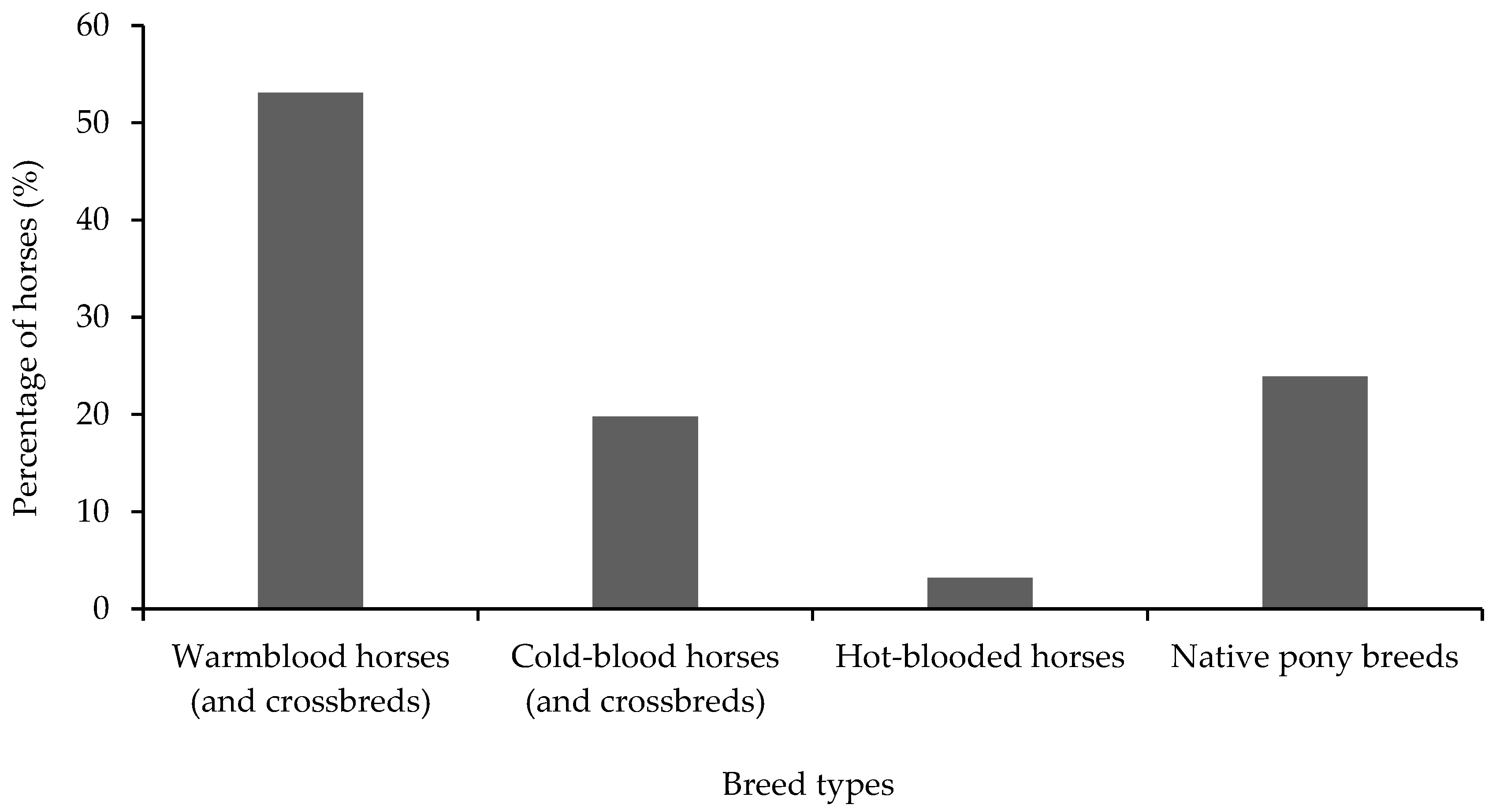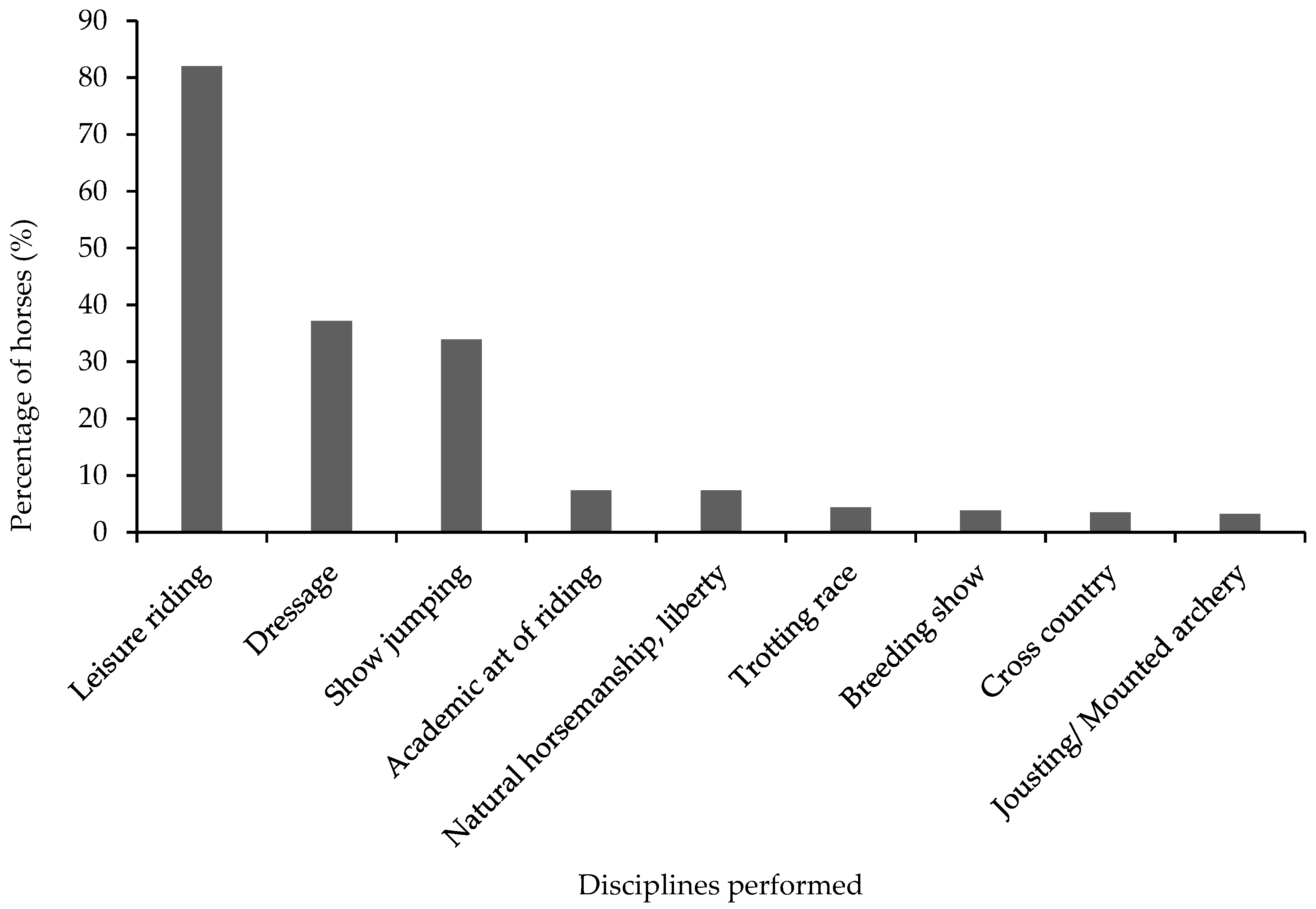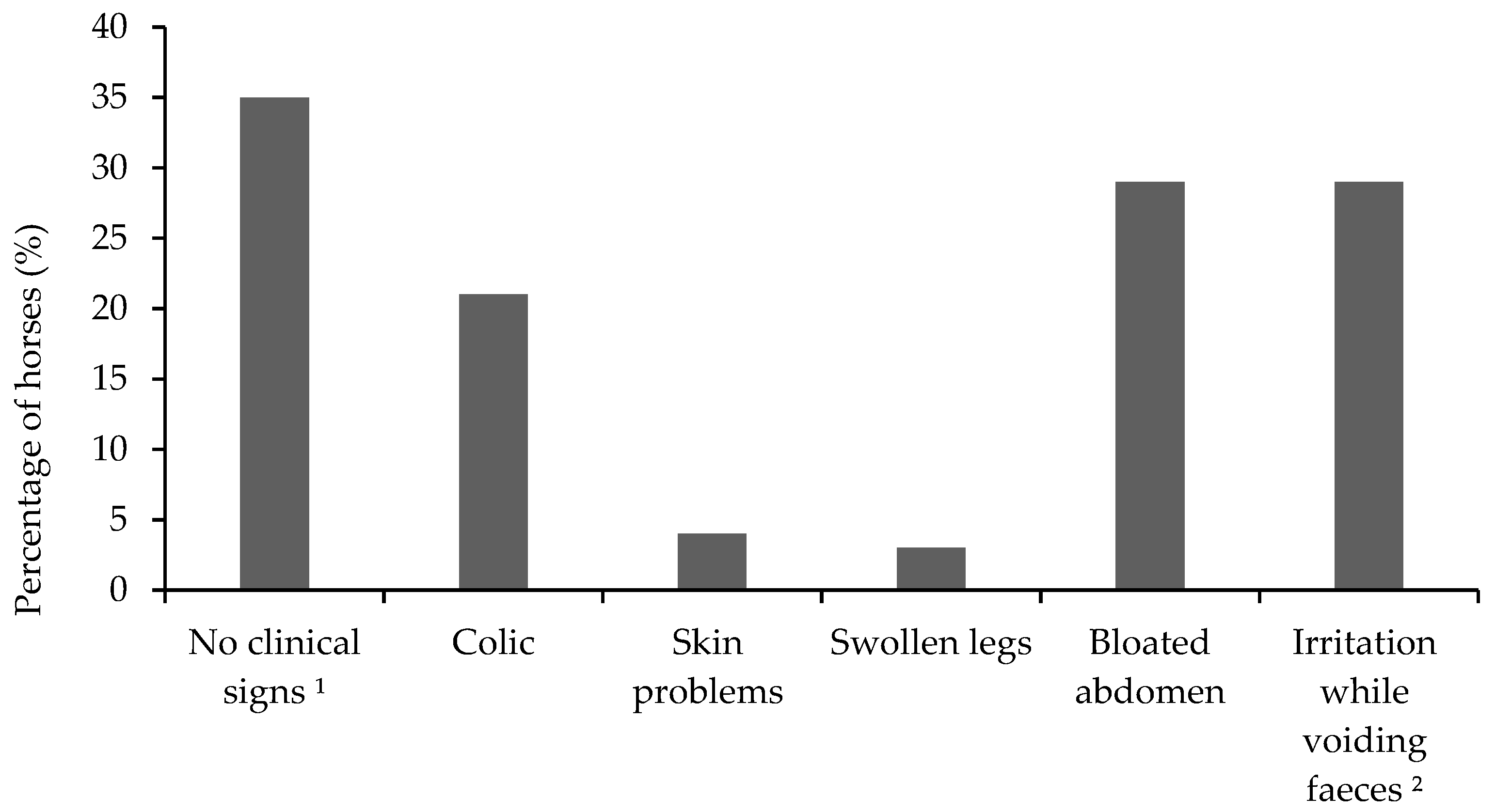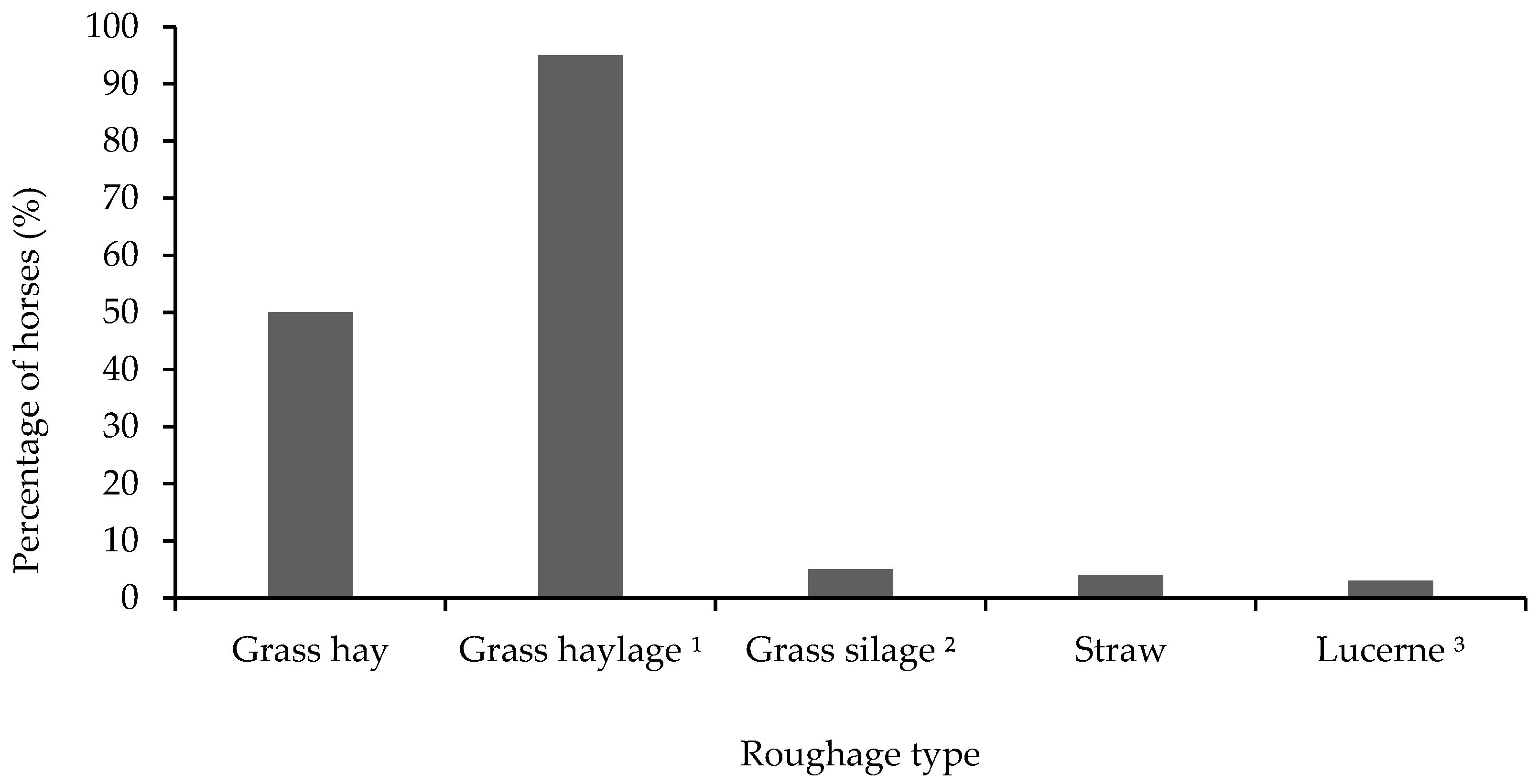Differential Defecation of Solid and Liquid Phases in Horses—A Descriptive Survey
Abstract
Simple Summary
Abstract
1. Introduction
2. Materials and Methods
2.1. Data Collection
2.2. Data Treatment
2.3. Calculations and Statistical Analysis
3. Results
3.1. Horses and Signs of Free Faecal Liquid
3.2. Management
3.3. Feeding
3.4. Gastrointestinal Health
3.5. Stereotypic Behaviour
4. Discussion
4.1. Horses
4.2. Management
4.3. Feeding
4.4. Gastrointestinal Health
4.5. Stereotypic Behaviour
4.6. Survey Response and Limitations of the Study
5. Conclusions
Supplementary Materials
Author Contributions
Funding
Acknowledgments
Conflicts of Interest
Abbreviations
| BCS | Body Condition Score |
| DM | Dry matter |
| FFL | Free faecal liquid |
| FMT | Faecal microbiota transplantation |
| GIT | Gastrointestinal tract |
| RDC | Right dorsal colon |
Appendix A
| Variables | Total Number of Horses | % of All Horses |
|---|---|---|
| Horses showing FFL when fed wrapped forages | 339 | 100 |
| Region of stable | ||
| Southern | 126 | 37 |
| Central | 81 | 24 |
| North | 39 | 12 |
| Western 1 | 23 | 7 |
| Eastern 1 | 70 | 21 |
| Horse imported | ||
| No | 253 | 75 |
| Do not know | 6 | 2 |
| Yes | 80 | 24 |
| Ability of horse to keep desired BCS | ||
| Easy keeper | 97 | 29 |
| Normal | 187 | 55 |
| Hard keeper | 55 | 16 |
| Type of water source in stable/loose housing system | ||
| Frostless waterer | 49 | 14 |
| Frostless tub | 43 | 13 |
| Waterer | 31 | 9 |
| Tub | 31 | 9 |
| Bucket | 78 | 23 |
| Natural water source | 4 | 1 |
| Combination of bucket and waterer | 103 | 30 |
| Type of water source in paddock during winter | ||
| Frostless waterer | 34 | 10 |
| Frostless tub | 80 | 24 |
| Waterer | 4 | 1 |
| Tub | 124 | 37 |
| Bucket | 37 | 11 |
| Natural water source | 5 | 1 |
| Other (Combination of tub and bucket, bucket and waterer) | 55 | 16 |
| Type of pasture | ||
| Pasture on arable land | 106 | 31 |
| Natural pasture | 135 | 40 |
| Forest | 6 | 2 |
| No pasture | 30 | 9 |
| Other (Combination of different pasture types) | 61 | 18 |
| Type of water source on pasture | ||
| Frostless waterer | 45 | 13 |
| Frostless tub | 12 | 4 |
| Waterer | 10 | 3 |
| Tub | 165 | 49 |
| Bucket | 8 | 2 |
| Natural water source | 33 | 10 |
| Other (Combination of bucket and tub) | 66 | 19 |
| Access to saltlick while on pasture | ||
| Yes | 220 | 65 |
| No | 119 | 35 |
| Saltlick in stable/loose housing system | ||
| Yes | 296 | 87 |
| No | 43 | 13 |
| Time from last deworming | ||
| Not dewormed | 11 | 3 |
| 0–3 months ago | 75 | 22 |
| 4–6 months ago | 126 | 37 |
| 7–12 months ago | 68 | 20 |
| >1 year ago | 59 | 17 |
| Origin of the forage | ||
| Bought | 226 | 67 |
| Produced on farm, but not by the owner | 42 | 12 |
| Produced on farm by the owner | 69 | 20 |
| Other | 1 | 0 |
| Forages analysis | ||
| Yes | 144 | 42 |
| No | 163 | 48 |
| Do not know | 37 | 9 |
| Number of feedings of forage per day | ||
| 1 time | 1 | 0 |
| 2 times | 14 | 4 |
| 3 times | 122 | 36 |
| 4 times | 108 | 32 |
| >4 times | 33 | 10 |
| Free access | 89 | 26 |
| Storage of forage | ||
| Indoors | 223 | 66 |
| Outdoors | 114 | 34 |
| Outdoors, covered | 65 | 19 |
| Outdoors, uncovered | 49 | 14 |
| Hay indoors, wrapped forages outdoors uncovered | 1 | 0 |
| Hay indoors, wrapped forages outdoors covered | 1 | 0 |
| Maximum time between two feedings of roughage | ||
| 0–2 h | 2 | 1 |
| 2–4 h | 35 | 10 |
| 4–8 h | 115 | 34 |
| 8–12 h | 101 | 30 |
| >12 h | 8 | 2 |
| Don’t know | 78 | 24 |
| Feeding strategy for roughage in paddock 2 | ||
| Forage not fed in the paddock | 27 | 8 |
| On the ground | 113 | 33 |
| In the feeding rack | 79 | 23 |
| In a haynet | 19 | 6 |
| In a tub or similar | 62 | 18 |
| Other (combination of ground and feeding rack/haynet) | 39 | 12 |
| Type of concentrate fed 2 | ||
| Grains | 16 | 5 |
| Molassed sugar beet pulp | 22 | 6 |
| Linseed/Linseed cake | 4 | 1 |
| Soybean meal | 14 | 4 |
| Potato protein | 33 | 10 |
| Wheat bran | 3 | 1 |
| Vegetable oil | 104 | 31 |
| No concentrate fed | 149 | 44 |
| Commercial concentrate | 118 | 63 |
| Number of concentrate feedings per day | ||
| 0 times | 149 | 44 |
| 1 time | 116 | 34 |
| 2 times | 107 | 32 |
| 3 times | 49 | 14 |
| 4 times | 7 | 2 |
| >4 times | 1 | 0 |
| Type of supplemental feeds fed 2 | ||
| Mineral feeds | 237 | 70 |
| Multivitamins | 58 | 17 |
| B-vitamins (and Biotin) | 10 | 3 |
| Selenium and Vitamin E | 9 | 3 |
| Garlic | 13 | 4 |
| Herbs | 8 | 2 |
| Other (Yeast, magnesium) | 93 | 27 |
| Not fed supplemental feeds | 51 | 16 |
| Storage of concentrates | ||
| In covered/closed containers indoors | 255 | 66 |
| In uncovered/open containers indoors | 11 | 3 |
| In paper bags/original package indoors | 18 | 5 |
| No concentrate | 51 | 15 |
| Other | 4 | 1 |
| Previous treatment of other gastro-intestinal diseases | ||
| No | 296 | 87 |
| Don’t know | 11 | 3 |
| Yes | 32 | 9 |
References
- Kienzle, E.; Zehnder, C.; Pfister, K.; Gerhards, H.; Sauter-Louis, C.; Harris, P. Field study on risk factors for free fecal water in pleasure horses. J. Equine Vet. Sci. 2016, 44, 32–36. [Google Scholar] [CrossRef]
- Ertelt, A.; Gehlen, H. Free fecal water in the horse-an unsolved problem. Pferdeheilkunde 2015, 31, 261–268. (In German) [Google Scholar] [CrossRef]
- Zehnder, C. Field Study on Risk Factors for Free Faecal Water in Leisure Horses. Ph.D. Thesis, Ludwig-Maximilians-Universität München, Munich, Germany, 6 February 2009. (In German). [Google Scholar]
- Laustsen, L.; Edwards, J.; Smidt, H.; van Doorn, D.; Luthersson, N. Assessment of faecal microbiota transplantation on horses suffering from free faecal water. In Proceedings of the 9th European Workshop on Equine Nutrition, Swedish University of Agricultural Science, Uppsala, Sweden, 16–18 August 2018. [Google Scholar]
- Valle, E.; Gandini, M.; Bergero, D. Management of chronic diarrhea in an adult horse. J. Equine Vet. Sci. 2013, 33, 130–135. [Google Scholar] [CrossRef]
- Gordon, C.H.; Derbyshire, J.C.; Wiseman, H.G.; Kane, E.A.; Melin, C.G. Preservation and feeding value of alfalfa stored as hay, haylage and direct-cut silage. J. Dairy Sci. 1961, 44, 129–131. [Google Scholar] [CrossRef]
- Finner, M.F. Harvesting and handling low-moisture silage. Trans. ASAE 1966, 9, 377–381. [Google Scholar] [CrossRef]
- Jackson, N.; Forbes, T.J. The voluntary intake by cattle of four silages differing in dry matter content. Anim. Sci. 1970, 12, 591–599. [Google Scholar] [CrossRef]
- Enhäll, J.; Nordgren, M.; Kättström, H. Horses in Sweden; Report 2012:1; The Swedish Board of Agriculture: Jönköping, Sweden, 2012. (In Swedish)
- Larsson, A.; Müller, C.E. Owner reported management, feeding and nutrition-related health problems in Arabian horses in Sweden. Livest. Sci. 2018, 215, 30–40. [Google Scholar] [CrossRef]
- Vik, J.; Farstad, M. Horse, Horse Management and Feeding: The Status of Horse Husbandry in Norway; Norsk senter for Bygdeforskning: Trondheim, Norway, 2012. (In Norwegian) [Google Scholar]
- Gerstner, K.; Liesegang, A. Effect of a montmorillonite-bentonite-based product on faecal parameters of horses. J. Anim. Physiol. Anim. Nutr. (Berl.) 2018, 102, 43–46. [Google Scholar] [CrossRef]
- Carroll, C.L.; Huntington, P.J. Body condition scoring and weight estimation of horses. Equine Vet. J. 1988, 20, 41–45. [Google Scholar] [CrossRef]
- Heldt, T.; Macuchova, Z.; Alnyme, O.; Andersson, H. Socio-Economic Effects of the Equine Industry. Falun: Dalarna University. (Report 2018:04). Available online: https://hastnaringen-i-siffror.se/files/Hästnäringens_samhällsekonomi_rapport2018_4_2.pdf (accessed on 5 November 2018). (In Swedish).
- Hartmann, E.; Bøe, K.E.; Jørgensen, G.H.M.; Mejdell, C.M.; Dahlborn, K. Management of horses with focus on blanketing and clipping practices reported by members of the Swedish and Norwegian equestrian community. Anim. Sci. J. 2017, 95, 1104–1117. [Google Scholar] [CrossRef]
- Ross, S.E.; Murray, J.K.; Roberts, V.L.H. Prevalence of headshaking within the equine population in the UK. Equine Vet. J. 2018, 50, 73–78. [Google Scholar] [CrossRef]
- Wylie, C.E.; Ireland, J.L.; Collins, S.N.; Verheyen, K.L.P.; Newton, J.R. Demographics and management practices of horses and ponies in Great Britain: A cross-sectional study. Res. Vet. Sci. 2013, 95, 410–417. [Google Scholar] [CrossRef] [PubMed]
- Wyse, C.A.; McNie, K.A.; Tannahil, V.J.; Love, S.; Murray, J.K. Prevalence of obesity in riding horses in Scotland. Vet. Rec. 2008, 162, 590–591. [Google Scholar] [CrossRef] [PubMed]
- Hofmanová, B.; Vostrý, L.; Majzlík, I.; Vostrá-Vydrová, H. Characterization of greying, melanoma, and vitiligo quantitative inheritance in Old Kladruber horses. Czech J. Anim. Sci. 2015, 60, 443–451. [Google Scholar] [CrossRef]
- Niinistö, K.E.; Määttä, M.A.; Ruohoniemi, M.O.; Paulaniemi, M.; Raekallio, M.R. Owner-reported clinical signs and management-related factors in horses radiographed for intestinal sand accumulation. J. Equine Vet. Sci. 2019, 80, 10–15. [Google Scholar] [CrossRef] [PubMed]
- Kilcoyne, I.; Dechant, J.E.; Spier, S.J.; Spriet, M.; Nieto, J.E. Clinical findings and management of 153 horses with large colon sand accumulations. Vet. Surg. 2017, 46, 860–867. [Google Scholar] [CrossRef]
- Müller, C.E. Equine digestion of diets based on haylage harvested at different plant maturities. Anim. Feed Sci. Technol. 2012, 177, 65–74. [Google Scholar] [CrossRef]
- Müller, C.E. Silage and haylage for horses. Grass Forage Sci. 2018, 73, 815–827. [Google Scholar] [CrossRef]
- Muhonen, S.; Julliand, V.; Lindberg, J.E.; Bertilsson, J.; Jansson, A. Effects on the equine colon ecosystem of grass silage and haylage diets after an abrupt change from hay. J. Anim. Sci. 2009, 87, 2291–2298. [Google Scholar] [CrossRef]
- Daly, K.; Proudman, C.J.; Duncan, S.H.; Flint, H.J.; Dyer, J.; Shirazi-Beechey, S.P. Alterations in microbiota and fermentation products in equine large intestine in response to dietary variation and intestinal disease. Br. J. Nutr. 2012, 107, 989–995. [Google Scholar] [CrossRef]
- Fernandes, K.A.; Kittelmann, S.; Rogers, C.W.; Gee, E.K.; Bolwell, C.F.; Bermingham, E.N.; Thomas, D.G. Faecal microbiota of forage-fed horses in New Zealand and the population dynamics of microbial communities following dietary change. PLoS ONE 2014, 9, e112846. [Google Scholar] [CrossRef] [PubMed]
- Müller, C.E.; Von Rosen, D.; Udén, P. Effect of forage conservation method on microbial flora and fermentation pattern in forage and in equine colon and faeces. Livest. Sci. 2008, 119, 116–128. [Google Scholar] [CrossRef]
- Lopes, M.A.; White, N.A., II; Crisman, M.V.; Ward, D.L. Effects of feeding large amounts of grain on colonic contents and feces in horses. Am. J. Vet. Res. 2004, 65, 687–694. [Google Scholar] [CrossRef] [PubMed]
- Clarke, L.L.; Roberts, M.C.; Argenzio, R.A. Feeding and digestive problems in horses: Physiologic responses to a concentrated meal. Vet. Clin. N. Am. Equine Pract. 1990, 6, 433–450. [Google Scholar] [CrossRef]
- Jones, S.L.; Spier, S.T. Pathophysiology of colonic inflammation and diarrhea. In Equine Internal Medicine; Reed, S.M., Bayly, W.M., Eds.; WB Saunders: Philadelphia, PA, USA, 1998; pp. 678–679. [Google Scholar]
- Tinker, M.K.; White, N.A.; Lessard, P. Descriptive epidemiology and incidence of colic on horse farms: A prospective study. In Proceedings of the 5th Equine Colic Research Symposium, The University of Georgia, Athens, GA, USA, 26–28 September 1994. [Google Scholar]
- Tinker, M.K.; White, N.A.; Lessard, P.; Thatcher, C.D.; Pelzer, K.D.; Davis, B.; Carmel, D.K. Prospective study of equine colic risk factors. Equine Vet. J. 1997, 29, 454–458. [Google Scholar] [CrossRef]
- Hudson, J.M.; Cohen, N.D.; Gibbs, P.G.; Thompson, J.A. Feeding practices associated with colic in horses. J. Am. Vet. Med. Assoc. 2001, 219, 1419–1425. [Google Scholar] [CrossRef]
- Luthersson, N.; Nielsen, K.H.; Harris, P.; Parkin, T.D. The prevalence and anatomical distribution of equine gastric ulceration syndrome (EGUS) in 201 horses in Denmark. Equine Vet. J. 2009, 41, 619–624. [Google Scholar] [CrossRef]
- Sandin, A.; Skidell, J.; Häggström, J.; Nilsson, G. Postmortem findings of gastric ulcers in Swedish horses older than age one year: A retrospective study of 3715 horses (1924–1996). Equine Vet. J. 2000, 32, 36–42. [Google Scholar] [CrossRef]
- Niedźwiedź, A.; Kubiak, K.; Nicpoń, J. Endoscopic findings of the stomach in pleasure horses in Poland. Acta Vet. Scand. 2013, 55, 45. [Google Scholar] [CrossRef]
- Hillyer, M.H.; Taylor, F.G.R.; Proudman, C.J.; Edwards, G.B.; Smith, J.E.; French, N.P. Case control study to identify risk factors for simple colonic obstruction and distension colic in horses. Equine Vet. J. 2002, 34, 455–463. [Google Scholar] [CrossRef]
- Traub-Dargatz, J.L.; Kopral, C.A.; Seitzinger, A.H.; Garber, L.P.; Forde, K.; White, N.A. Estimate of the national incidence of and operation-level risk factors for colic among horses in the United States, spring 1998 to spring 1999. J. Am. Vet. Med. Assoc. 2001, 219, 67–71. [Google Scholar] [CrossRef] [PubMed]
- Normando, S.; Canali, E.; Ferrante, V.; Verga, M. Behavioral problems in Italian saddle horses. J. Equine Vet. Sci. 2002, 22, 117–120. [Google Scholar] [CrossRef]
- Christie, J.L.; Hewson, C.J.; Riley, C.B.; McNiven, M.A.; Dohoo, I.R.; Bate, L.A. Management factors affecting stereotypies and body condition score in nonracing horses in Prince Edward Island. Can. Vet. J. 2006, 47, 136. [Google Scholar] [PubMed]
- Normando, S.; Meers, L.; Samuels, W.E.; Faustini, M.; Ödberg, F.O. Variables affecting the prevalence of behavioral problems in horses. Can riding style and other management factors be significant? Appl. Anim. Behav. Sci. 2011, 133, 186–198. [Google Scholar] [CrossRef]
- McGreevy, P.D.; French, N.P.; Nicol, C.J. The prevalence of abnormal behaviors in dressage, eventing and endurance horses in relation to stabling. Vet. Rec. 1995, 137, 36–37. [Google Scholar] [CrossRef] [PubMed]
- Luescher, U.A.; McKeown, D.B.; Dean, H.A. Cross-sectional study on compulsive behaviour (stable vices) in horses. Equine Vet. J. 1998, 27, 14–18. [Google Scholar] [CrossRef]
- McGreevy, P.D.; Cripps, P.J.; French, N.P.; Green, L.E.; Nicol, C.J. Management factors associated with stereotypic and redirected behaviour in the thoroughbred horse. Equine Vet. J. 1995, 27, 86–91. [Google Scholar] [CrossRef]
- Bachmann, I.; Audige, L.; Stauffacher, M. Risk factors associated with behavioural disorders of crib-biting, weaving and box-walking in Swiss horses. Equine Vet. J. 2003, 35, 158–163. [Google Scholar] [CrossRef]
- Redbo, I.; Redbo-Torstensson, P.; Odberg, F.O.; Henderdahl, A.; Holm, J. Factors affecting behavioural disturbances in racehorses. Anim. Sci. 1998, 66, 475–481. [Google Scholar] [CrossRef]





| Item | No. of Horses | % of Horses |
|---|---|---|
| Country (stabled in) | ||
| Sweden | 191 | 56 |
| Norway | 148 | 44 |
| Gender | ||
| Mare | 134 | 40 |
| Gelding | 194 | 57 |
| Stallion | 11 | 3 |
| Coat colour | ||
| Bay | 123 | 37 |
| Chestnut | 64 | 19 |
| Grey | 47 | 14 |
| Black | 27 | 8 |
| Paint | 24 | 7 |
| Palomino/Isabelline | 21 | 6 |
| Cremello | 19 | 6 |
| Other (Leopard pattern/buckskin) | 14 | 4 |
| Body condition score 1 | ||
| <3 | 75 | 22 |
| 3 | 188 | 55 |
| >3 | 76 | 22 |
| Training intensity | ||
| Low | 215 | 63 |
| Medium | 63 | 19 |
| High | 23 | 7 |
| Breaking in | 23 | 7 |
| No training 2 | 15 | 4 |
| Item | No. of Horses | % of Horses |
|---|---|---|
| Housing system (n = 337) | ||
| Individual box | 271 | 79 |
| Loose housing system | 64 | 19 |
| Group housing | 2 | 1 |
| Bedding (n = 336) | ||
| Straw | 67 | 20 |
| Shavings | 57 | 17 |
| Combination of straw and shavings | 125 | 37 |
| Sawdust | 40 | 12 |
| Wood pellets | 26 | 8 |
| Straw pellets | 11 | 3 |
| Other (paper, mix of sawdust and peat, rubber mat, raw sawdust) | 10 | 3 |
| Time spent per day in paddock during winter (n = 245) | ||
| <4 h | 5 | 2 |
| 4–7 h | 67 | 20 |
| 8–12 h | 163 | 48 |
| >12 h | 10 | 30 |
| Paddock ground (n = 332) | ||
| Grass (old grass during winter) | 94 | 28 |
| Sand/Gravel | 79 | 24 |
| Soil | 133 | 40 |
| Other | 26 | 8 |
| Annual time spent on pasture | ||
| <4 weeks | 5 | 2 |
| 4–8 weeks | 67 | 20 |
| 9–12 weeks | 163 | 48 |
| >12 weeks | 100 | 30 |
| No pasture | 4 | 1 |
| Anthelmintic routines | ||
| Regularly dewormed ≥ 1 times per year | 122 | 36 |
| Dewormed due to high 1 egg counts ≥ 1 times per year | 154 | 45 |
| Dewormed due to high 1 egg counts < 1 times per year | 34 | 10 |
| Dewormed if considered necessary | 25 | 7 |
| Not dewormed | 4 | 1 |
| Item | No. of Horses | Min | Q1 | Q2 | Q3 | Max | Mean | SD |
|---|---|---|---|---|---|---|---|---|
| Roughage and concentrate feeding, Kg/100 kg BW/d 1 | ||||||||
| Grass hay | 165 | 0.1 | 0.2 | 0.2 | 0.3 | 0.5 | 0.2 | 0.06 |
| Grass haylage | 251 | 0.2 | 1.7 | 2.0 | 2.3 | 6.0 | 2.0 | 0.67 |
| Grass silage | 4 | 1.2 | 1.2 | 2.9 | 3.8 | 4.7 | 2.9 | 1.73 |
| Straw | 14 | 0.1 | 0.2 | 0.3 | 0.6 | 2.3 | 0.4 | 0.45 |
| Lucerne 2 | 10 | 0.01 | 0.1 | 0.1 | 0.2 | 0.7 | 0.1 | 0.13 |
| Total amount of roughage | 217 | 0.3 | 1.5 | 2.0 | 3.1 | 4.8 | 1.8 | 2.17 |
| Total amount of concentrate | 190 | 0.01 | 0.1 | 0.2 | 0.3 | 1.0 | 0.2 | 0.18 |
| Roughage proportion of total feed ration (%) 3 | 249 | 20 | 90 | 100 | 100 | 100 | 90 | 0.14 |
| Concentrate proportion of total feed ration (%) 3,4 | 107 | 0 | 1 | 5 | 10 | 80 | 7 | 0.14 |
| Mineral supplementation, g/100 kg BW | 218 | 0.1 | 6.0 | 10.8 | 17.8 | 83.3 | 13.5 | 11.43 |
| Item | No. of Horses | % of Horses |
|---|---|---|
| Faecal appearance less loose when changing from wrapped forage to hay | 198 | 58 |
| Faecal appearance less loose when changing from wrapped forage to pasture | 157 | 46 |
| Faecal appearance less loose when changing to another batch of wrapped forage | 56 | 17 |
| No change in faecal appearance with any change in feeding | 24 | 7 |
| Faecal appearance more loose in association to changing feeds | 20 | 6 |
| Faecal appearance less loose when changing from primary to regrowth harvest 1 | 16 | 5 |
| Faecal appearance less loose when using feed additives 2 | 8 | 4 |
| Have not tried any change in feeding | 5 | 2 |
© 2020 by the authors. Licensee MDPI, Basel, Switzerland. This article is an open access article distributed under the terms and conditions of the Creative Commons Attribution (CC BY) license (http://creativecommons.org/licenses/by/4.0/).
Share and Cite
Lindroth, K.M.; Johansen, A.; Båverud, V.; Dicksved, J.; Lindberg, J.E.; Müller, C.E. Differential Defecation of Solid and Liquid Phases in Horses—A Descriptive Survey. Animals 2020, 10, 76. https://doi.org/10.3390/ani10010076
Lindroth KM, Johansen A, Båverud V, Dicksved J, Lindberg JE, Müller CE. Differential Defecation of Solid and Liquid Phases in Horses—A Descriptive Survey. Animals. 2020; 10(1):76. https://doi.org/10.3390/ani10010076
Chicago/Turabian StyleLindroth, Katrin M., Astrid Johansen, Viveca Båverud, Johan Dicksved, Jan Erik Lindberg, and Cecilia E. Müller. 2020. "Differential Defecation of Solid and Liquid Phases in Horses—A Descriptive Survey" Animals 10, no. 1: 76. https://doi.org/10.3390/ani10010076
APA StyleLindroth, K. M., Johansen, A., Båverud, V., Dicksved, J., Lindberg, J. E., & Müller, C. E. (2020). Differential Defecation of Solid and Liquid Phases in Horses—A Descriptive Survey. Animals, 10(1), 76. https://doi.org/10.3390/ani10010076




